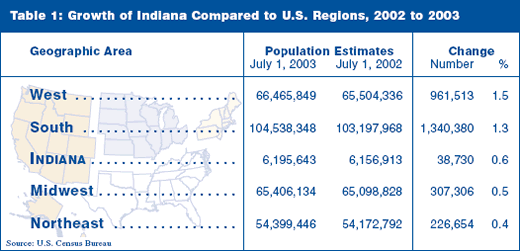Indiana's Population Gains: What's Our Rank?
| Download spreadsheet with detailed population change data for all 50 states and the District of Columbia |
In December, the U.S. Census Bureau released new population estimates
for each of the 50 states and the District of Columbia. According to these
figures, Indiana’s population had grown to almost 6.2 million by
the summer of 2003, and the state kept its rank as the 14th largest. Lest
the reader think the question in this article’s title has been thoroughly
answered in the first paragraph, let us continue on and explore a variety
of ways to answer it.
Among its Midwestern neighbors, Indiana is holding its own—but in fractions. Indiana’s annual rate of growth during these early years of the new century continues to be less than 1 percent and is reminiscent of the 1980s. The latest data show Indiana’s growth rate between 2002 and 2003 was 0.6 percent, only 0.1 percentage points higher than the growth of the Midwest and 0.2 percentage points higher than that of the Northeast (see Table 1).

The estimates show the continued shift of the population to the southern and western portions of the United States (see Figure 1). The four states with the fastest growth from 2002 to 2003 share warm weather characteristics. They are Nevada, with a 3.4 percent growth rate; Arizona, at 2.6 percent (and this state will likely surpass Indiana’s population by the end of the decade); Florida, at 2 percent; and Texas, at 1.8 percent.

Notable exceptions to the frequently observed relationship between warmer weather and higher population growth rates are Idaho and Delaware, which rank fifth and seventh, respectively. California and Hawaii round out the top 10. By this particular measure, Indiana holds the distinction of being ranked 31st.
Of course, if we focus on changes in absolute numbers, we paint a somewhat different picture (see Figure 2). By this criterion, a slightly larger group of cold-weather states gets a piece of the high-growth action.

While California, Texas and Florida overwhelmingly dominate this contest of sheer numbers, the states of Illinois, Washington, New Jersey, Maryland and New York each make a very respectable showing (see Table 2). How does the Hoosier state compare via this measure? We fared a bit better than we did by percentage, clocking in at number 18 with an increase of 38,730 people.

An Opportunity to Offset Brain Drain?
Notably, North Dakota and the District of Columbia were the only areas to lose population during the 2002 to 2003 time period, decreasing by 74 and 5,773 people, respectively. Interestingly, the district added nearly 50,000 nonfarm jobs between 1998 and 2002, while experiencing a population gain of fewer than 4,000 over the same period; thus, people holding those jobs seem more likely to live in surrounding states. In light of this, perhaps Maryland’s growth is not quite as surprising.
In any case, the long travel times for those commuting workers, combined with the high cost of living in the district, may encourage some D.C. employees to eventually seek employment elsewhere. In fact, this was the case for Amber Dodez-Kostelac, IBRC data manager. Kostelac explains, “Although entry-level positions attract college graduates across the nation to the district, oftentimes the cost of living in D.C. is so expensive that these new graduates find themselves living in surrounding states such as Virginia, Maryland and, in some cases, as far as West Virginia.”
Could it be that we have uncovered a specific opportunity to help offset Indiana’s so-called brain drain? Our relatively low cost of living is one thing that could be leveraged to try to offset, as well as slow down, brain drain. Of course, brain drain is a topic deserving of its own article; but for our current purposes, suffice it to say that such efforts would help preserve our relative standing in the population growth competition at hand.
Progress So Far This Decade
Comparing nearby states, the estimated population growth from July 1, 2000, to July 1, 2003, was about the same for Illinois, Indiana and Kentucky (each at 1.7 percent), and slightly more in Wisconsin (1.8 percent). Growth was relatively slow for Michigan (1.2 percent) and Ohio (0.6 percent). However, all of these were lower than the growth of the nation over the same period (3.1 percent).
Of the 10 states that have a population estimate between 5 million and 7.4 million for 2003, Indiana ranked ninth in growth over the three-year period (see Table 3). Only Massachusetts had slower growth, yielding an increase of just 1.1 percent. Arizona tops this list of peers, stampeding along at an 8 percent three-year growth rate.

Our immediately trailing peer is the state of Washington, with a 2003 estimate of about 6.1 million. Although we’ve managed to edge out that state so far, it has a three-year growth rate of 3.7 percent, which is 2 percentage points higher than ours. If these trends continue, Washington’s population will exceed Indiana’s by almost 60,000 in the summer of 2006. Sticking out our necks a bit further with our three-year growth assumptions, Indiana’s population would extend about 20,000 beyond that of Massachusetts by July of 2024. Is anyone taking any bets on that?
Carol O. Rogers
Associate Director, Indiana Business Research Center,
Kelley School of Business, Indiana University
Vincent Thompson
Economic Analyst, Indiana Business Research Center,
Kelley School of Business, Indiana University
